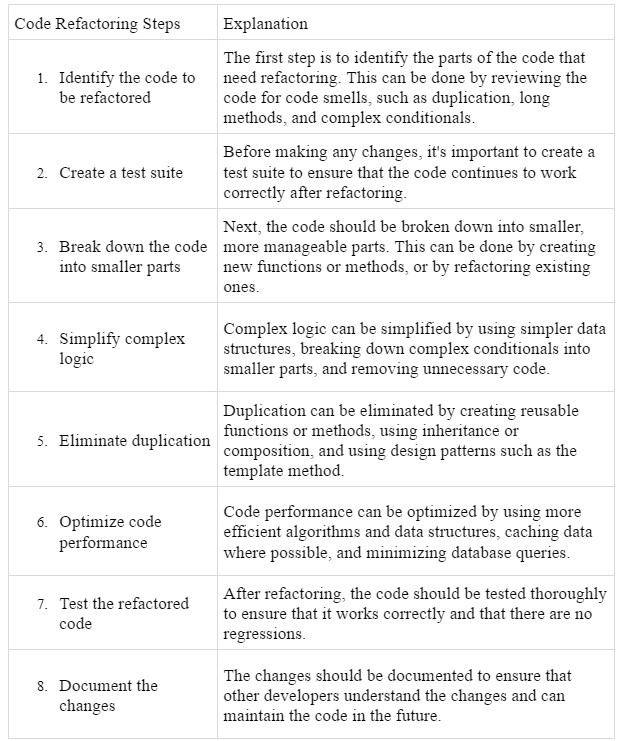The basics of code refactoring
- Created at:
- Updated at:
The relevance of code refactoring is obvious to the developer, but most clients and managers need additional arguments in favor of this decision. From the point of view of the performer, refactoring is a mandatory step in development, as it contributes to the simplification of the code and its maintenance, making it more readable. Thus, the purity and simplicity of the code, its scalability, maintainability and security are improved, while maintaining the same level of functionality.
This is where questions arise. The client has no clue why to spend money on tasks that do not make the code faster or more functional; moreover, the benefits of refactoring for the development of the business as a whole are becoming even more nebulous.
What code refactoring means
When the source code is restructured without changing standard functions of the program, we are talking about code refactoring. Due to it, the structure and design are improved, productivity is growing, the program can be scaled and simplified.
At first glance, it may seem that the impact of refactoring is purely technical, but it is not. In the long term, businesses receive a number of preferences, getting rid of the need to cover technical debt in the next few years.
The term technical debt, by the way, was coined metaphorically by Ward Cunningham and is used to refer to the cost of fixing your application code that was previously written using shortcuts.
When refactoring should be made
There is another metaphorical notion - "a code smell". Martin Fowler interprets it as the first sign of major problems in the system, which will inevitably lead to errors and failures in the future. That is the right time when it is worth refactoring the code quickly to avoid technical debt.
What are the signs that signal about urgent need in code refactoring?
- Bulky and difficult to read code;
- Frequent duplication of the code;
- A lot of conditional operators in the design.
Programmers may advise against refactoring if they consider the code to be clean based on such characteristics:
- Clarity of logic that does not mask bugs;
- Minor dependencies that make maintenance easy;
- Excellent performance;
- Minimizing the number of entities (methods, classes, functions, etc.).
Martin describes refactoring as a mandatory process after every feature expansion. Practice shows that it is optimal to refactor the project after deployment, when the performance has been tested on the experience of real users.
Developers do not write the flawless code
Most programmers don't write clear code all at once. The reasons may be different. The limited time plays a role: the allocated time period is just not enough to create a flawless code right away under client's and other team specialists' pressure.
The second factor is that the work is not prioritized. For example, after the programmer has completed one task, he is obliged to do the next one, so there is simply lack of time to eliminate that very “code smell”.
Finally, the lack of understanding of the problem on the part of the developer, blind coding, difficult readability of the code are the reasons why you have to do refactoring in the future.
How code refactoring solves technical debt
Technical debt describes what happens when development teams take action to speed up delivery at the expense of quality, which subsequently leads to refactoring. In other words, it is the result of prioritizing delivery speed over perfect code. Programmers talk about technical debt as something to be done in the future.
There are various causes of technical debt.:
- Poor code quality;
- Low qualification of IT management or staff;
- Gaps in team communication;
- Lack of documentation;
- Disappearance or obsolescence of libraries and technologies;
- Poor software testing.
Thus, the demand for technical support from the contractor in the future will be minimal. One of the key benefits of refactoring is the ability to minimize technical debt by eliminating inaccuracies, duplicates, and unreadable places in the code. Thus, the demand for technical support from the contractor in the future will be minimal.
Business value
By finalizing the code, the programmer helps the client save money that in a couple of years will have to be spent on correcting system errors and “closing” holes in the company’s work. The fact is that code without refactoring tends to increase technical debt, which means that the prospect of losses will only grow.
Refactoring is aimed primarily at improving key functions - user management, authorization, billing. After that, the work of analytical systems improves, and upon completion of the improvement of the core, work in other areas follows.
Another advantage is that the risks are reduced. Conducting security tests through code re-engineering is easier and faster. This allows you to find and quickly fix those gaps that would allow hackers to break into the system in the future.
Stages of code refactoring
Refactoring can also be planned, rather than basing on obvious signs, such as reading difficulties, etc. This methodology is more rational, because it does not create unnecessary haste in order to quickly solve all the tasks. By planning refactoring, the programmer can allocate enough time to optimize the code, clean it up, improve readability, and so on.
Important: each refactoring action must be accompanied by testing, otherwise code damage and serious problems with the functionality itself cannot be avoided. So how is refactoring done?
- Testing is performed before refactoring to eliminate the risk of errors in the code after. They are executed on the part of the code that will be altered. В
- Reflections on how the changes will affect functionality.
- Analysis of the project architecture.
- Code refactoring. The selection of refactoring methods and classes is based on how they work in a particular case.
- Launching code tests - automatic or manual (carried out after the automated ones to confirm the success of the first ones and consolidate the result). If a significant problem is found, a reset is the solution: this ensures that an optimally functioning product is created.

Summary
Refactoring in coding has become a turning point in programming, contributing to a better understanding the problems with writing code. The Software Development Hub team is working on projects for healthcare, electronic accounting, education, etc.; adheres to the principle that it is possible to create a competitive application by eliminating all possible risks.
CMO
Digital Marketing & IT for Sustainability
Popular posts
-
5 Ways to Improve SEO on Your DIVI Website
- 1
- 0
-
How to Build Reporting APIs Better, Stronger and Faster
- 1
- 0
-
10 Best Apps that Help You Boost a Conversion Rate of Shopify Store
- 2
- 0
-
Is Your Website Ready for These 28 Types of DDoS Attacks?
- 1
- 0
-
7 Best Features of Big Sur to Try Now
- 4
- 0
-
How to block ads on YouTube (video)
- 0
- 0
